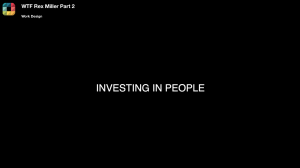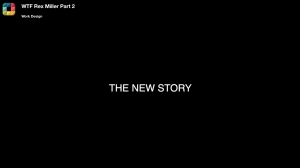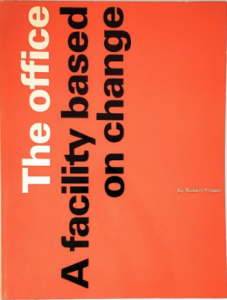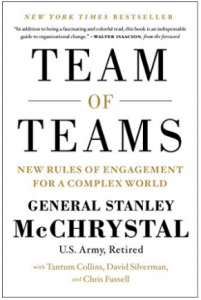This Content Is Only For Paid Subscribers
Welcome to our new docuseries exploring what is happening to the office through the lens of trusted and emerging thinkers. There was so much to learn from guest, Rex Miller. Get access to part 1 here!
In part two of his conversation, Rex stresses the importance of why leadership needs to adapt to the changing business landscape by looking both inward and outward. Learn about the new skills managers must develop to be better equipped to handle the social and emotional needs of their teams.
Watch Next Video
Video Transcript
The Reaction (1:01)
 Rex Miller: I think leadership is still in a very reactive mode. You know, they’re just trying to get back the churn, the loss of legacy knowledge in the organization, not able to really look out, and not able to look inward to the true condition of their people or even understand it. It’s hard to look out to the future.
Rex Miller: I think leadership is still in a very reactive mode. You know, they’re just trying to get back the churn, the loss of legacy knowledge in the organization, not able to really look out, and not able to look inward to the true condition of their people or even understand it. It’s hard to look out to the future.
It’s hard to look outside, take risk, and try something new. Nobody wants to take risk today. It’s a tricky situation, which means the only way out is to adapt. And for courage in leadership, leaders have to take courage. I recommend they all read the book called Tempered Resilience by Tod Bolsinger.
We’re trying to make people happy. What we need to be doing is leading into a new future and building the, that’s what Lewis Horne did. You know, when he said, we’re going to get rid of private offices, he wasn’t hailed as the great savior coming in, but what he did is he built a coalition of people willing to go learn.
It’s called Discovery Leadership, and he said, I don’t know the answers, but we can find the answers. He broke everybody into different areas, study groups on different aspects of what the future could look like, brought it back, and it was a collective effort as opposed to an architect driven effort or a developer driven effort.
Developing Managers (2:35)
 So Dr. Jernigan said that up to 25 – 30% of the population has experienced trauma. Now that’s over, the average is 4% of the population has PTSD. There is a process, it’s using cognitive behavior therapy in its storytelling, but it’s group based, and it goes through six processes. In the workbook, I’ll provide a link, a free link to your listeners, to the workbook, but we go through the six elements and we give some examples of story templates, and so helping teams reconnect, heal, tell their stories, process in a safe environment. And we build these story templates so that managers have the tools to be able to do this and don’t have to be experts and don’t have to get outside an uncomfortable territory.
So Dr. Jernigan said that up to 25 – 30% of the population has experienced trauma. Now that’s over, the average is 4% of the population has PTSD. There is a process, it’s using cognitive behavior therapy in its storytelling, but it’s group based, and it goes through six processes. In the workbook, I’ll provide a link, a free link to your listeners, to the workbook, but we go through the six elements and we give some examples of story templates, and so helping teams reconnect, heal, tell their stories, process in a safe environment. And we build these story templates so that managers have the tools to be able to do this and don’t have to be experts and don’t have to get outside an uncomfortable territory.
From a design standpoint, companies need to start with the manager. So here’s the dilemma manager’s face. Gallup says that only 18% of managers have the natural capacity to be, to have those social emotional skills to coach and develop. Most of them, 82%, are what we call those task driven managers. Managers have had to become life coaches and we’re stuck in this, who makes the decision as to who comes in the office? Is it the company? That’s not been working. Do we give it to the employees? That’s not working. So we’ve gotta put a lot of emphasis in building up managers.
I think managers are in the similar dilemma as teachers. Teachers have to be, you know, we called schools, the new field hospitals in America because of all the social and emotional needs kids have that teachers have to fulfill that they’ve never been trained for. And so we’ve got to go through this re-skilling of the managers and have them in the forefront of designing, how can you help me facilitate my team?
So I think they’re the leverage point in the Achilles heel that we need to put a lot of time in designing for their needs. It’s what Stanley McChrystal did, right with ‘Team Of Teams’. He designed a structure to empower their platoons to go out into unknown conditions, make judgements in real time, have lots of real time data and make decisions. But they had to upskill their people and get rid of the territorial feeling that the Army had for the Navy and the Marines and the Navy Seals and the Rangers and all that. They had to build a team of teams, and I think that’s a perfect metaphor for where we need to start with design, with HR, re-skilling and build the managers back up.
Investing In People (5:42)
 One of the things we learned in ‘The Healthy Workplace Nudge’ is that we’re advocates for sustainability. We’re advocates for health and wellbeing. Your client may not be, and so, first of all, defining what level your client is at. You know, have a taxonomy to know, here’s the playing field we have. So I’ve divided them into three levels, and there’s intermedium levels, but the basic level is the company’s transactional with their employees. I think probably 80% of companies fall in that mode. Then you have what I call the value add, where they see employees as a value add and they wanna enhance that value. That’s the war on talent. That’s the talent development side. The third one is they see their employees with intrinsic worth. Those would be the Patagonias, the Barry-Wehmillers, the Cummins Diesels. They don’t see employees as value add. They see them as we’re investing because we believe in you, and we’ll find the right place for you.
One of the things we learned in ‘The Healthy Workplace Nudge’ is that we’re advocates for sustainability. We’re advocates for health and wellbeing. Your client may not be, and so, first of all, defining what level your client is at. You know, have a taxonomy to know, here’s the playing field we have. So I’ve divided them into three levels, and there’s intermedium levels, but the basic level is the company’s transactional with their employees. I think probably 80% of companies fall in that mode. Then you have what I call the value add, where they see employees as a value add and they wanna enhance that value. That’s the war on talent. That’s the talent development side. The third one is they see their employees with intrinsic worth. Those would be the Patagonias, the Barry-Wehmillers, the Cummins Diesels. They don’t see employees as value add. They see them as we’re investing because we believe in you, and we’ll find the right place for you.
The New Story (6:53)
 Don’t survey people. That is so worthless, to survey and ask what people want. I mean, nobody knows what they want. What they want is they don’t want to disrupt their current flow and lifestyle and do something different. I mean, that’s obvious, right? Two years. You don’t need surveys to tell you that. They don’t know what they want in the workplace. Here’s the analogy that I think would be useful. When you remember the circus, what does the circus remind you of? Big tent, elephants, lion taming act, clowns, dust on the ground, peanuts, trapeze. What did Cirque du Soleil do to it? It’s the same. It’s the same thing, but they created storyline and narrative and choreography and all of this. It was called a circus, you know, just a French word.
Don’t survey people. That is so worthless, to survey and ask what people want. I mean, nobody knows what they want. What they want is they don’t want to disrupt their current flow and lifestyle and do something different. I mean, that’s obvious, right? Two years. You don’t need surveys to tell you that. They don’t know what they want in the workplace. Here’s the analogy that I think would be useful. When you remember the circus, what does the circus remind you of? Big tent, elephants, lion taming act, clowns, dust on the ground, peanuts, trapeze. What did Cirque du Soleil do to it? It’s the same. It’s the same thing, but they created storyline and narrative and choreography and all of this. It was called a circus, you know, just a French word.
I think that’s where we are with the workplace, is that we’re still thinking of it as the circus or the classroom with desks in a row, and employees still have that mindset too. So you can’t give them something new if you’re not using a different story and a narrative and imagery, and it’s like this kind of analogy.
When Herman Miller came out with Action Office, nobody knew what to do with it. They did a road tour. They demonstrated because it was a concept too far beyond. The story, the reason why we do things, that’s where we gotta start. The new story, the new reason, the human-centric, you know, going from facilities based on change we need now, agile is the new word, we’ve got to define that, but facilities based on humans, facilities based on care. What does that look like? And I’ll circle back. It begins with the manager. So they have to be reeducated and believe in the new value. You know, go from what they said, sage on the stage, the guide on the side.
Same thing we have to do in the workplace with managers. Instead of being the person who directs work, troubleshoots and holds accountability, how do they now become the coaches and, and the guides to teams and empowering teams to do what they do best? And unless we help reacclimate them and show them the tools that they have and help them find out how to redistribute the stress they have and help the team rise up to it.
We’re going to be back to the same thing. We’re going to have the same conversation again a year from now.
The Value Of Coming Together (9:38)
 For me, my hope, the positive future is that companies will get a vision for the value of face to face. There are things you can do, first of all, you only build empathy face to face. My ability to put myself in your shoes, suspend my judgment, work collaboratively together. So remote kills that for schools and we see in schools, kids are coming back and teachers are saying kids are coming back not ready to learn. What they mean is their social emotional skills are gone. They don’t know how to sit still, play well with others, self-regulate.
For me, my hope, the positive future is that companies will get a vision for the value of face to face. There are things you can do, first of all, you only build empathy face to face. My ability to put myself in your shoes, suspend my judgment, work collaboratively together. So remote kills that for schools and we see in schools, kids are coming back and teachers are saying kids are coming back not ready to learn. What they mean is their social emotional skills are gone. They don’t know how to sit still, play well with others, self-regulate.
So companies that see the value, the long-term value of the two main socializing institutions of work and school, preserving that. Otherwise, I’m very concerned that as a nation, our ability to work through these really big differences is going to continue to decline. Empathy dropped 18% during the pandemic. Narcissism raised. Why? We’re on our own and we’re making our own decisions, and we’re doing what I want to do, we’re making the world about us. I don’t think that’s healthy on a long term basis. So I think there’s a vital need for companies to figure this thing out and make coming together attractive, useful, valuable to everybody.
Navigating The Future (11:09)
 The game, the positive game-changers can be technology. Dr. Roizen says that within the next 10 years, our longevity curve is going to increase 10 years because of the technology coming in. There could be another iPhone, there could be another reorganizing structure of how businesses succeed. So there’s these things we can’t predict, but we can model them and go down different scenarios.
The game, the positive game-changers can be technology. Dr. Roizen says that within the next 10 years, our longevity curve is going to increase 10 years because of the technology coming in. There could be another iPhone, there could be another reorganizing structure of how businesses succeed. So there’s these things we can’t predict, but we can model them and go down different scenarios.
Best case scenario, probable scenario, worst case scenario, and then stuck. Nothing changes. And we can build models, put different variables in there and begin to see how they play out. And then from that, we can, you know, we can then begin to influence towards the future we want to see.
3 Things To Do Right Now:
- Prioritize getting a good night of sleep.
- Cultivate five close relationships that are with you through thick and thin.
- Know what you can control and what you can’t control, and focus on what you can.
Mentioned Reading:
Resources:
- Rex Miller’s Website
- The River Rose Experience
- The Resilience Lab Podcast
- Publications by Rex Miller
Meet Rex Miller:

Rex Miller is a renowned expert in optimizing human and team performance, strategic foresight, and organizational transformation. With over 20 years as a consultant and coach, he has authored six Wiley books and received numerous accolades, including the CoreNet Global Innovator Award, the Industry Excellence Award, and IFMA’s Distinguished Author Award.
Rex is celebrated for his mastery in guiding large capital project teams to work together efficiently and progressing swiftly along the learning curve. He excels at helping teams overcome the infamous Forming-Storming hump.
Rex has written numerous books including The Commercial Real Estate Revolution: Nine Transforming Keys to Lowering Cost, Cutting Waste and Driving Change in a Broken Industry; Change Your Space, Change Your Culture, The Healthy Workplace Nudge and WHOLE. He has won the CoreNet Global InnovatorAward, Industry Excellence Award and IFMA’s Award for Excellence.
Episode 1 Part 2 Credits:
- Created By Bob Fox
- Produced By Work Design Magazine
- Directed By Bob Fox
- Edited By Katie Sargent & Bob Fox
- Special Thanks to Amanda Gram & Malena Boylan



